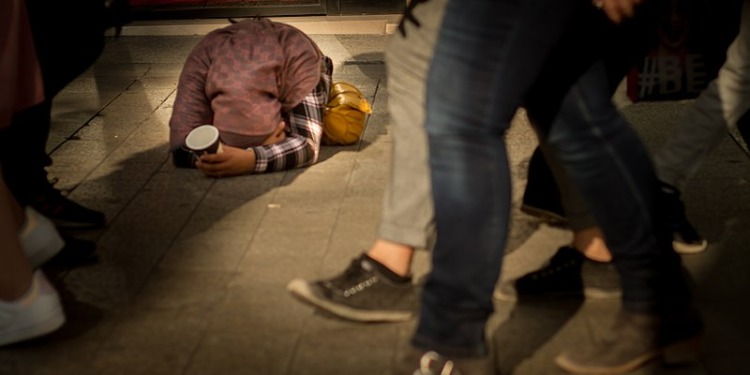According to Eurostat, the statistical office of the European Union (EU), in 2021, the at-risk-of-poverty rate for young people aged 15-29 was 20.1%. This was higher than the at-risk-of-poverty rate (16.8%) for the total population.
Young people were at a higher risk of poverty than the total population in a total of 19 EU countries. Denmark, Greece, Spain, Romania, Italy and Sweden had the highest percent at risk – around 25% – with the biggest gap between young people and the total population being in Denmark (25.6% compared to 12.3%) and Sweden (24.6% compared with 15.7%).
At the lower end of the scale, Slovenia and Ireland had around 10% of young people at risk of poverty, while Czechia had the lowest percentage of young people at risk of poverty with just 8.6% – equal to that of their total population.
In eight EU countries, young people were actually less at risk of poverty compared to the population as a whole. The biggest differences were in Latvia (17.0% of young people compared to 23.4% of the total population), Malta (11.3% compared with 16.9%), Estonia (15.7% compared with 20.6%) and Croatia (14.7% compared with 19.2%).
In 2021, the at-risk-of-poverty rate in the EU for young people aged 15-29 was 20.1%.
Highest in:
Denmark (25.6%)
Greece (25.3%) and
Spain (24.9%)
Lowest in:
Czechia (8.6%)
Slovenia (9.9%) and
Ireland (10.3%)
Find out more: https://t.co/gbwjsHgjLL pic.twitter.com/PsDYDoVXru
— EU_Eurostat (@EU_Eurostat) April 4, 2023
While these statistics show young people were more likely to be at risk of poverty across the EU in 2021, the actual severe material and social deprivation rate in the EU was similar for young people and the total population – 6.1% and 6.3% respectively. Severe material and social deprivation is an indicator used by the EU to distinguish individuals who cannot afford certain goods, services, or social activities. Indicators include a household being unable to deal with an unexpected cost or having access to a car while for individuals it includes access to the internet or having two pairs of shoes.
Romania had the highest number of young people severely materially and socially deprived at 23.1%. This was followed by Bulgaria with 18.7% and Greece at 14.2%.
However, in 11 EU countries – Luxembourg, Poland, Sweden, Cyprus, Czechia, Netherlands, Croatia, Slovenia, Finland, Austria, and Estonia – this was the case for less than 3% of young people..
These newly published figures are the most up to date published by Eurostat.
Children at risk of poverty in the EU
In a report published last month, Save the Children, an international NGO which works to improve the lives of children, highlighted how the Covid-19 pandemic, cost-of-living crisis, and climate change were all worsening child poverty.
They reported that almost 1 in 4 children (24.4%) under the age of 18 in the EU were at risk of poverty at the end of 2021 – an increase from 22.8% in 2019.
“Europe is one of the world’s wealthiest regions, yet it is facing increasing numbers of children and families experiencing poverty and social exclusion,” wrote Save the Children.
Related Articles: The Inadequacy of EU Migration Policy Can No Longer Be Ignored | Child Poverty: the Little Victims of the Russia-Ukraine War | Fences, Stronger Borders and Pushbacks: The Current State of the EU Migration Debate | EU Bans the Sale of CO2-Producing Cars After 2035
Save the Children highlighted the European Child Guarantee as a way to help solve the issues facing children. Adopted in June 2021, it is the first EU level policy instrument aimed at addressing childhood disadvantage and exclusion, requesting EU Member States to provide vulnerable children with free access to early childhood care, free education and school based activities, at least one healthy meal each school day, healthcare, adequate housing and healthy nutrition.
PRESS RELEASE: Over 200,000 more children were driven to the brink of poverty in EU countries in 2021, bringing the total number of children at risk of poverty to over 19.6 million – or one in four – according to a new report by Save the Children.https://t.co/BYwDBOB0ak
— Save the Children Europe (@SaveChildrenEU) March 7, 2023
Action plans were meant to be proposed by each Member State to outline how they would implement the European Child Guarantee, which would form the basis of their plans that would be put into place until 2023. However, almost two years after the European Child Guarantee was adopted and a year after the plans were meant to be submitted, eight EU countries – Austria, Germany, Hungary, Latvia, Lithuania, Romania, Slovakia, Slovenia – have still not done so.
According to Save the Children, the various crises facing Europe have meant “millions of children in Europe are experiencing poverty and social exclusion”.
“Child poverty is not only a threat to the future of Europe. It is also a pan European emergency at this very moment,” states the NGO.
The EU’s own data shows that children and young people face an increased risk of poverty, and while policies like the European Child Guarantee represent a great step forward, work is far from done.
Editor’s Note: The opinions expressed here by the authors are their own, not those of Impakter.com — In the Featured Photo: A girl begs for change on a Parisian sidewalk. Featured Photo Credit: Wikimedia Commons











